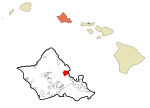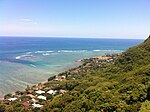Kualoa Regional Park
Beaches of OahuGeography of Honolulu County, HawaiiHawaii geography stubsHistory of OahuParks in Hawaii

Kualoa Regional Park is located at Kāneʻohe Bay, on the island of Oahu in the U.S. state of Hawaii. The park covers 153 acres (61.92 ha; 0.24 sq mi) across the road from the Pali-ku (cliffs) of the Koʻolau Range. The beach front is white sand and 1/3 mile offshore is the small basalt island of Mokoliʻi (or Chinaman's Hat). The site is popular with watchers of wetland birds, such as the Japanese white-eye, Red-crested cardinal, White-rumped shama, Black-crowned night heron, Black-necked stilt, Nutmeg mannikin, Black noddy, Wedge-tailed shearwater, White-tailed tropicbird, Red-tailed tropicbird, Common myna, Common waxbill, Cattle egret and a variety of others.
Excerpt from the Wikipedia article Kualoa Regional Park (License: CC BY-SA 3.0, Authors, Images).Kualoa Regional Park
Kualoa Park Drive,
Geographical coordinates (GPS) Address Nearby Places Show on map
Geographical coordinates (GPS)
| Latitude | Longitude |
|---|---|
| N 21.511 ° | E -157.837 ° |
Address
Kualoa Park Drive
96730
Hawaii, United States
Open on Google Maps










